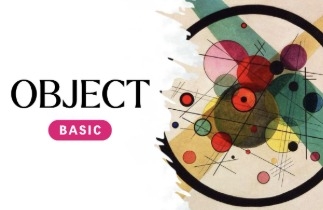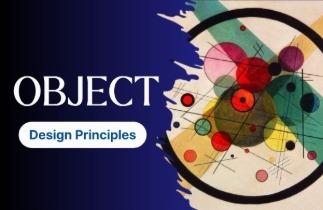
Objects - Basics
eternity
Learn object-oriented design methods, represented by the responsibility-driven design method, and explore how to make design tradeoffs in terms of cohesion, coupling, and encapsulation.
초급
software-design, oop
Learn various design principles needed to write object-oriented code, focusing on working code.

Object-Oriented Design Principles
Identifying code problems using design principles
How to evolve code through refactoring
Relationship between Tests and Code Quality
Who is this course right for?
Those curious about the concepts and application methods of Object-Oriented Design Principles
Those who find it difficult to apply object-oriented concepts in code
For those who need basic principles and guides for designing good code
Need to know before starting?
Java basic syntax
Experience writing code using object-oriented languages
2,459
Learners
161
Reviews
100
Answers
5.0
Rating
2
Courses
객체지향 설계와 도메인-주도 설계에 관심이 많으며 행복한 팀과 깔끔한 코드, 존중과 협력이 훌륭한 소프트웨어를 낳는다는 믿음을 가지고 있는 평범한 개발자입니다. 개발자, 교육자, 관리자를 오가며 익힌 다양한 경험을 바탕으로 좋은 코드와 함께 좋은 프로덕트를 만들기 위해 노력하고 있습니다.
저서로는 『객체지향의 사실과 오해』와 『오브젝트』가 있고 번역서로는 『엘레강트 오브젝트』가 있으며 『만들면서 배우는 클린 아키텍처』에 감수자로 참여했습니다.
💡멘토링 신청 : https://inf.run/YvAd2
💡개인블로그 : https://eternity-object.tistory.com/
All
33 lectures ∙ (6hr 16min)
Course Materials:
All
41 reviews
5.0
41 reviews
Reviews 16
∙
Average Rating 4.9
5
It's an honor to leave the first review. After completing `<Object - Basics>`, I immediately took `<Object - Design Principles>` as well and am now writing this review. The advantages of the course are as follows: 1. It's easy to understand intuitively because it's not just listing principles but includes actual code examples. ㄴ I thought I knew the SOLID principles because I encounter them often, but after watching the lecture, I realized that was my misconception. 2. Convenience has increased compared to `<Object - Basics>`. ㄴ A link to the relevant repo is provided through the course materials, making it easy to access. ㄴ The presenter is no longer visible, making the presentation much easier to see. There are also some slightly disappointing aspects (They are minor). 1. The volume level differs slightly for each video, which is a bit distracting. 2. There are also cases where there are errors in the videos. 3. If colloquial phrases like '되게 됩니다.' were refined, it would feel tidier. 4. There are instances where the notation for foreign words differs (e.g., 메서드/메소드), and it would be a bit tidier if this were unified. I highly recommend watching `<Object - Basics>` as well. It allows for a broader understanding of the course. If you don't know what object-oriented design is, I strongly recommend this course. I plan to recommend it to many people around me as well 😊😊 Thank you to Jo Young-ho for planning this great course. I expect my code to change significantly in the future. Work less, earn more 😊😊😊
I remember you recently left a review for "Object - Basic Course", and you've already completed it. Congratulations on completing the course, and thank you for leaving a review. :) I'm glad the course was helpful. I decided to remove my face from the videos at the request of many acquaintances, and I'm glad the reaction has been positive... Due to health reasons, the filming period was extended, which resulted in slightly varying audio levels. If anyone finds this inconvenient, I will consider re-recording "Object - Basic Course" along with it in the future. :) I'm creating, filming, and editing the course by myself, and this course ended up having more presentation slides than expected. Although I checked in between, it seems there were parts I didn't notice. I apologize for releasing it without thoroughly checking this part. I will also review it again and make corrections as quickly as possible. :) If it's convenient for you, please let me know about any errors in the video or inconsistencies in the slides, and I will correct and update them as quickly as possible. The phrase "Work less, earn more" resonates with me. I hope the course helps reduce maintenance costs and improve code quality. Thank you!
Reviews 2
∙
Average Rating 5.0
5
I really enjoyed the lecture. I thought I knew the design principles well, but unexpectedly, there were many things I had misunderstood. Explaining using code made it easy to understand. I was unsure how to refactor code, but after the lecture, I was able to establish some clear criteria. Thank you for creating a great lecture!
Thank you for leaving a review, GaeBalInSaeng-nim. I'm glad the design principles, organized to be applicable when writing actual code, were helpful. :) If you have any questions, feel free to leave them anytime! Congratulations on completing the course, and have a happy start to your week.
Reviews 3
∙
Average Rating 5.0
5
It's exciting like watching a movie, as the story about design continues~ I'll keep listening carefully~ Thank you for the good lecture!
Thank you for leaving a review, Byung-mo Kim. It's structured to show how design principles are applied while improving examples, and it seems you're enjoying it. :) The difficulty increases slightly as you go towards the latter part, but more interesting content awaits, so please make sure to complete the course. If you have any questions or parts that need correction, please feel free to ask anytime. Have a great Friday night and spend happy days.
Reviews 2
∙
Average Rating 5.0
Edited
5
Following the basic course, this seems like the best lecture on object-oriented programming. It is very substantial as it is composed of well-structured content from concepts to examples.
Thank you for leaving a course review, soljie74. If 'Object - Basic' explained how to write object-oriented code, 'Object - Design Principles' aimed to explain how to improve design using object-oriented principles, and I'm glad it was helpful. If you have any questions or suggestions for improvement, please feel free to ask anytime. Congratulations on completing the course, and have a good rest of your weekend!
Reviews 6
∙
Average Rating 5.0
5
This is a premium lecture on the core principles and fundamentals of object-oriented development~ I can say there's a world of difference between developing with knowledge of these principles versus developing without them. If you're currently developing without knowing these principles, you'll eventually realize that you've been writing spaghetti code~!! :) Let's all keep fighting today to create code that's easy to maintain~ 😊
Thank you so much for leaving a review, Chris Park. As you mentioned, I hope many people will be able to write clean code based on design principles. I'm so grateful that you're satisfied with the course, and I'll work hard to prepare the next course as well! Have a happy weekend. :)
Limited time deal ends in 6 days
$77,000.00
30%
$84.70
Check out other courses by the instructor!
Explore other courses in the same field!